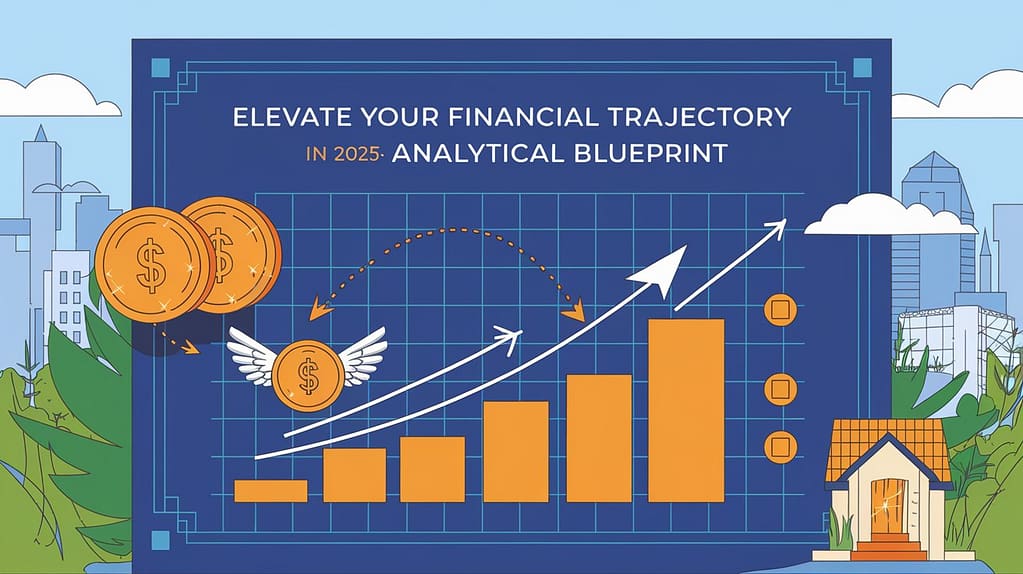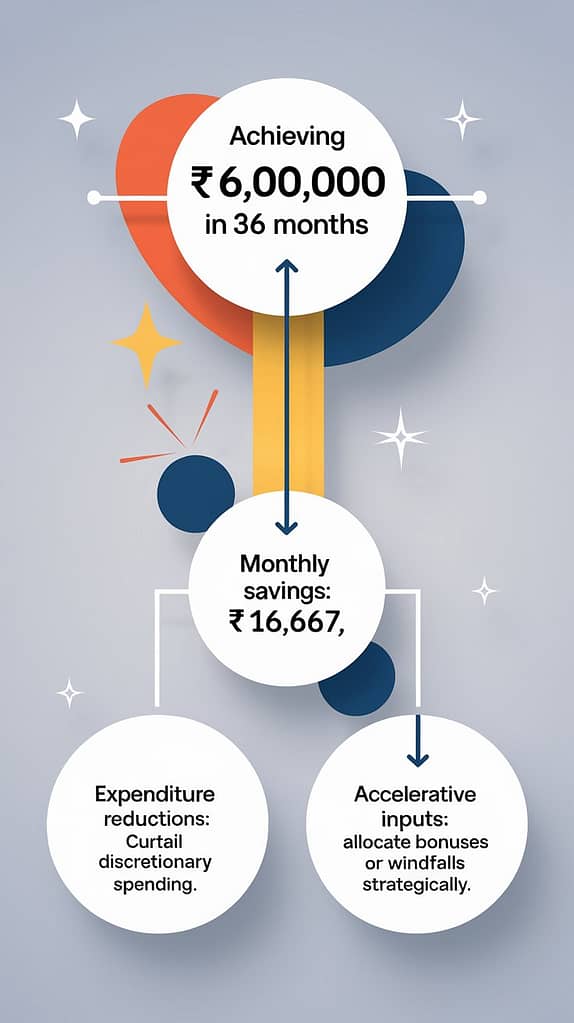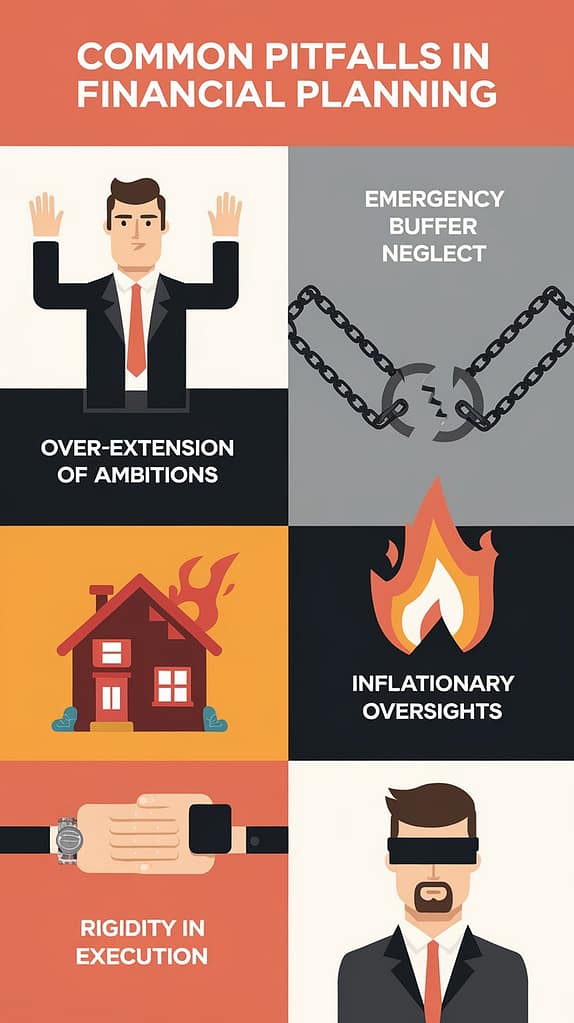
Introduction
In the intricate domain of personal finance, methodical planning, and robust goal-setting frameworks are essential for achieving sustainable economic well-being. This exposition delves into the theoretical and applied dimensions of financial goal-setting, emphasizing empirically validated techniques for enduring fiscal discipline and wealth generation.
Table of Contents
Theoretical Foundations of Financial Goal-Setting
Financial goals transcend mere monetary benchmarks, representing complex interactions of individual priorities, values, and ambitions. Framing these objectives within broader socio-economic and psychological contexts enhances their effectiveness and relevance.
Systemic Benefits of Defining Financial Objectives
- Strategic Orientation: Clear goals provide a roadmap, transforming vague intentions like “save money” into quantifiable objectives, such as “accumulate ₹1,00,000 within 12 months for an emergency fund.”
- Intrinsic and Extrinsic Motivation: Defined milestones act as psychological motivators, counteracting cognitive biases and impulsive tendencies.
- Enhanced Accountability: Tangible metrics foster self-regulation, enabling adaptive strategies as circumstances evolve.
- Optimized Resource Allocation: Strategic goal-setting reduces inefficiencies, fostering prudent expenditure and disciplined savings.
- Psychological Empowerment: Incremental achievements establish a reinforcing cycle of self-efficacy and aspirational growth.
Advanced Frameworks for Financial Goal-Setting
1. Critical Self-Appraisal and Prioritization
Reflective inquiry is foundational:
- What are the existential and aspirational aspects of my financial goals?
- How will achieving these objectives reshape my socio-economic trajectory?
- What sacrifices am I willing to make to fulfill these ambitions?
2. Leveraging SMART Principles
- Specific: Define goals with precision, e.g., “save ₹2,00,000 for a home down payment in 24 months.”
- Measurable: Incorporate metrics, such as “set aside ₹8,333 monthly.”
- Achievable: Align targets with income patterns and expenditure constraints.
- Relevant: Ensure objectives resonate with personal and cultural priorities.
- Time-Bound: Establish timelines to assess and recalibrate as needed.
3. Temporal Stratification of Goals
- Immediate Goals (≤1 Year): Emergency savings or short-term liquidity reserves.
- Intermediate Goals (1–5 Years): Asset purchases, education funding, or entrepreneurial investments.
- Long-Term Goals (>5 Years): Retirement planning, generational wealth accumulation, or philanthropic endeavors.
4. Comprehensive Financial Diagnostics
- Conduct granular analyses of income, fixed versus variable expenses, and asset-liability ratios.
- Utilize predictive modeling tools to simulate cash flows, net worth projections, and risk scenarios.
5. Incremental Decomposition of Objectives
Illustration: Achieving ₹6,00,000 in 36 months requires:

- Monthly savings: ₹16,667.
- Expenditure reductions: Curtail discretionary spending.
- Accelerative inputs: Allocate bonuses or windfalls strategically.
Sustaining Momentum: Advanced Strategies for Goal Adherence
1. Dynamic Monitoring and Feedback
- Employ AI-powered dashboards for real-time tracking.
- Schedule quarterly reviews to integrate economic shifts into financial strategies.
2. Automating Savings Mechanisms
- Establish automatic transfers to high-yield accounts.
- Explore robo-advisory platforms for optimized investment allocation.
3. Reinforcing Progress Through Rewards
- Celebrate milestones with rewards aligned to broader goals.
- Avoid counterproductive incentives that could derail progress.
4. Leveraging Social Accountability
- Engage with accountability groups or mentors for sustained focus.
- Participate in financial literacy forums to exchange strategies and insights.
Empirical Case Studies: Insights from the Indian Context
Ramesh: Achieving Aspirations through Incremental Discipline
Ramesh, a high school teacher, saved ₹2,50,000 over three years by:
- Conducting meticulous expense audits.
- Investing in fixed deposits with cumulative interest.
- Supplementing income through tutoring.
Priya: Financing a Debt-Free Wedding
Priya, a Bengaluru-based software engineer, accomplished her financial goal by:

- Allocating funds to a dedicated wedding account.
- Budgeting granularly for event-specific expenditures.
- Utilizing cashback schemes and vendor negotiations.
Common Pitfalls in Financial Planning

- Overextension of Ambitions: Unrealistic goals undermine motivation.
- Emergency Buffer Neglect: Ignoring contingencies disrupts plans.
- Inflationary Oversights: Failure to factor inflation skews projections.
- Rigidity in Execution: Overly rigid strategies hinder adaptability.
Advanced Resources for Financial Management
Cutting-Edge Tools
- Budgeting Apps: YNAB, Goodbudget.
- Investment Platforms: Zerodha Varsity, INDmoney.
Foundational Literature
- Housel, M. (2020). The Psychology of Money.
- Kiyosaki, R. (1997). Rich Dad Poor Dad.
Institutional Resources
- Reserve Bank of India (RBI) financial literacy initiatives.
- SEBI investor education programs.
Implementing Knowledge: Practical Steps
- Download our Comprehensive Financial Checklist.
- Explore related articles: Strategic Budgeting Frameworks.
- Share progress stories in our community forums.
- Seek tailored advice from certified financial planners.
Conclusion
Strategic financial goal-setting is indispensable for fostering autonomy and resilience. By embracing the methodologies detailed herein, individuals can systematically transform ambitions into measurable achievements. Embark on your financial journey today to establish a legacy of stability and empowerment.

